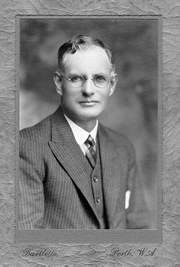

JCPML. Records of the Curtin Family. Mr Curtin, aged 52 - Federal Election 1937. JCPML00376/140.
For Curtin and Labor the outcome of the 1937 election at a time of returning economic prosperity was somewhat mixed. In the House of Representatives Labor won 29 seats or only two seats more than the combined Federal and State Labor tally in 1934 and still well short of the 45 for its coalition opponents though the UAP numbers were reduced to 29, a decline of 4 compared with 1934. In addition to Gwydir which had been won at the by election, the ALP picked up just the one extra seat in Victoria. By contrast, in the Senate the ALP outpolled its opponents in five of the six states winning 16 of the 19 seats being contested and coming within a few thousand votes of also capturing the three vacancies in South Australia which would have given it a majority in that chamber. In Western Australia veteran former Labor Senators George Pearce and Patrick Lynch were comprehensively defeated. Across the nation nearly 48.5 per cent of voters supported the ALP in the Senate compared with 46 per cent for the UAP and Country parties. In seeking to explain this anomalous outcome one can point, for example, to the result in New South Wales where Labor polled over 50 per cent of the vote in the Senate but less than 46 per cent in the House of Representatives, or to Western Australia where just under 50 per cent of electors voted Labor in the Senate but the party won only two of the House of Representatives seats. These results can be interpreted as indicating a reluctance of the part of voters at this stage to entrust the Treasury benches to Labor notwithstanding some sympathy with its policy stance. Not surprisingly, Day also suggests that Labor activists found the outcome ‘frustrating’ and some were inclined to blame Curtin for his ‘placidity’ during the campaign. 19
On a state-by-state basis in Victoria the ALP contested two fewer seats than in 1934 but received an additional 3 per cent of the primary vote: in Queensland by contrast its vote fell by 4 per cent partly due to a stronger performance by the Social Credit candidates. In South Australia Labor polled 5 per cent more of the votes than in 1934 but still won only one seat out of six leaving its best achievement in Tasmania where with the disappearance of the Social Credit party Labor polled over 50 per cent of the primary vote in retaining its three seats out of five. In Curtin’s own state of Western Australia Labor polled nearly 49 per cent of the House of Representatives primary vote,—that is only 1 per cent less than its Senate vote and well above its 1934 level (though that vote had been understated because there had been no election in Kalgoorlie in that year) but as already indicated Labor still won only two of the five House seats—Curtin’s own seat of Fremantle and the party stronghold in Kalgoorlie. In Forrest Labor’s vote rose after preferences from about 38 per cent to 45 per cent, and in Swan the increase was from 36 to 41 per cent but in Perth the Labor vote fell by about 4 per cent. For Curtin himself his vote in Fremantle represented an increase from 51 per cent after preferences in 1934 to 55 per cent on the primary vote, suggesting a swing in his favour of about 6 per cent. One can assume that Curtin’s long absence from Western Australia during the 1937 campaign was in part a reflection of his assessment that the situation in his own state was relatively strong though the result in the Perth seat in particular would have been a big disappointment.
In the light of what happened in 1940 it is also necessary to look more closely at the outcome in 1937. In the wake of the truce between federal and Lang Labor the parties nominated unified candidates in each seat though a few dissidents ran as independents. Labor’s primary vote in New South Wales in 1937 at 45.25 per cent was thus especially disappointing given that in the 1934 election NSW State and federal Labor combined had polled an almost identical 45.29 per cent of the primary vote—35.93 per cent for Lang Labor which won 9 seats, compared with 4 in 1931 plus a fifth in a subsequent by election, and 9.36 per cent for Federal Labor which won one seat compared with 3 in 1931. In that year the total Labor vote had been only 41.24 per cent a fall of more than 10 per cent from the winning 1929 total. It is important to note both that the presence of the dissident independents obviously detracted from the Labor vote in the House of Representatives and contributed to Labor gaining only one additional House seat in the state despite the fact that in the Senate vote the newly unified party won all vacant seats with a primary vote of over 50 per cent.